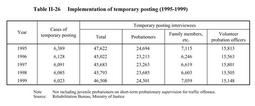| Previous Next Index Image Index Year Selection | |
|
|
3 Other measures (1)Classified treatment scheme
Classified treatment is a scheme whereby probationers are classified into"Class A"or"Class B"depending on the difficulty of their treatment, based on a judgment that takes account of scientific indicators as well as clinical opinion. Under the scheme, "Class A"probationers who pose numerous problems and whose treatment is expected to be difficult receive direct and positive treatment from probation officers. Fig. II-21 shows trends in the proportion of probationers and parolees classified as "Class A" since the classified treatment scheme was started in 1971. In recent years, the proportion of Class A has tended to increase for both adult parolees and adult probationers, showing that the number of probationers and parolees who are difficult to treat has increased. Fig. II-21 Trends in the "Class A" ratio (1971-Dec. 31st, 1999) (2)Categorized treatment scheme Categorized treatment is a scheme whereby the problematic nature and other characteristics of probationers and parolees(such as stimulant and solvent abusers)are categorized into 11 categories according to the nature of the crime or delinquency, social conditions, and other circumstances. Specific treatment guide lines are set for each category, and treatment is focused on these characteristics. As of December 31st, 1999, the category"Stimulant drug offences"accounted for 26.6% of adult parolees and 22.6% of adult probationers. The category"Connection with violent crime organizations"accounted for 3.8% and 4.7% and "Sexual offenses" for 4.6% and 3.9% of these two, respectively (source:Rehabilitation Bureau, Ministry of Justice). (3)Temporary posting system Temporary posting is a system whereby probation officers are posted to locations arranged in advance, such as municipal public institutions or halfway houses in the area where probationers live. Using this as a base, the officers actively and efficiently hold interviews with the probationers and parolees and their family members or other persons concerned, make home visits, and contact volunteer probation officers or other related groups and organizations. Concurrently, these probation officers also undertake work such as counseling local residents on delinquency and other problems. In halfway houses, interviews and other activities have been held from early evening into the night, or early in the morning after a night's stay at the halfway house. Table II-26 shows the number of cases of temporary posting and the number of persons interviewed in the posted location (probationers, etc. ) over the last 5 years. Table II-26 Implementation of temporary posting (1995-1999) (4)Intermediate treatment system for long-term sentenced parolees The system of intermediate treatment is designed to achieve a smooth transition from correctional treatment to probation for long-term sentenced inmates who have been granted parole. The parolees are accommodated in halfway houses for a fixed period at the beginning of their parole, when this is deemed appropriate by the Regional Parole Board and has the parolee's agreement. In principle, these parolees are allowed to commute to external workplaces, while also receiving planned and intensive treatment with a focus on training for daily life, using either individual or group methods. In 1999, intermediate treatment was given to 103 such parolees(source:Rehabilitation Bureau, Ministry of Justice). |

